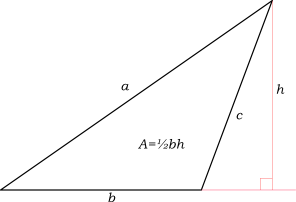Triangle
This article is about the geometric shape. For the drafting tool, see Triangle (tool).
A triangle is a two dimensional polygon with three sides meeting at three corners. Alternatively it is three distinct points connected by straight lines called sides.
Several different types of triangles exist:
- An equilaterial triangle is one such that each angle is the same (60 degrees), and each side is of the same length.
- An isosceles triangle is one that has two sides of equal length, and two interior angles equal. In an isosceles triangle, the angles which are formed by the equal sides with the unequal side are equal to each other.
- An obtuse triangle is one that has one angle which is greater than 90 degrees.
- An acute triangle is one such that all three angles are less than 90 degrees.
- A right triangle is one that has one 90 degree angle.
Properties of triangles
The sum of the three interior angles of any triangle is 180 degrees. The area of a triangle is equal to one-half times the length of one side times the altitude relative to that side. (Altitude is the distance of the corner opposite the base from the line which contains the base. In an obtuse triangle, the altitude may be measured from a point not in the base.) In a right triangle, the base and the altitude are the two sides which meet at the right angle.
Heron's formula for the area of a triangle uses only the lengths of the sides, and is:
where and are the lengths of the three sides.




